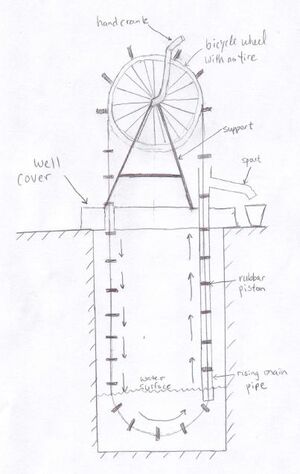
The equations on this project need to be checked.. The original rope pump is a relatively inexpensive solution for pumping water out of relatively deep man-made wells. Using multiple pistons connected to a rope, the pipe system sits partially underwater, while the user turns a crank above the well. As the crank turns, the rope is moved down into the well, up the pipe system, and around the crank wheel, repeating itself over and over again. As the rope passes through the partially submerged pipe system, these pistons connected to the rope draw water up the pipe system, to a spout at the surface, where the water can be used.
The original rope pump contains drawbacks, such as depth limitations, multiple piping sizes for different depths and one standard force needed to pump, which some may find too easy or too difficult to pump.
The depth adjustable rope pump uses an adjustable pipe system to solve these problems. Using only one PVC pipe size to draw up water at any depth up to 60 meters, this length of pipe may be lowered or raised at any time. If a user finds it too difficult to pump, the pipe system may be pulled upward, removing a discrete length of pipe from the water surface. This decreased pipe penetration into the water leads to less water being pumped up to the surface, thus a smaller force on the user.
Similarly, if a user feels that not enough water is being pumped, and the force is too light, the adjustable pipe system can be lowered to provide more water.
Background[edit | edit source]
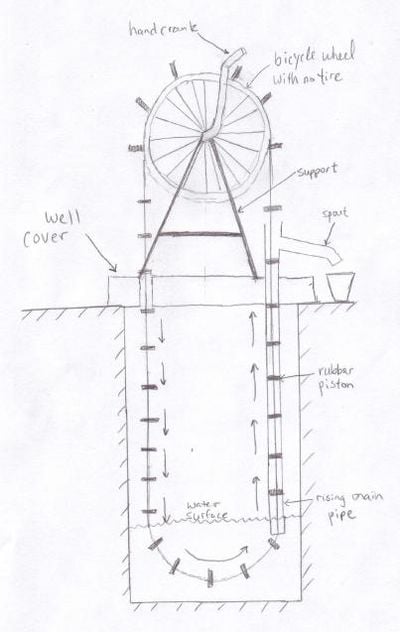
|
Figure 1 - A basic rope pump schematic
History[edit | edit source]
Rope pumps were first developed as a relatively inexpensive solution for drawing water out of wells up to 50 metres deep. Within the 1970's and 80's, specifically in Nicaragua, many different rope pump designs began to emerge - specifically the one shown in figure 1 above. Once the foundation for this technology was discovered, the 1980's proved to be a major optimization period for the new technology. Quite possibly, the most significant development in the 80's was the ability to inject plastics into moldings, leading to the use of inexpensive PVC pipes. Not only being inexpensive, the durable, long lasting and rust-preventative nature of polyvinyl-chloride has led to its continual use in rope pumps in this present day.[1]
The Standard Rope Pump[edit | edit source]
Figure 1 shows a simple diagram of how the standard rope pump developed in the 1980's works. Above the hand-dug well is a bicycle wheel without its tire (the inner rings of a used car tire clamped together can also be used), which is able to freely rotate about its axis. Connected via chain to the bicycle wheel is another pinion, which contains the pedals (or hand crank) used to turn the wheel. Different sizes of pinions can be used to further limit the load needed, however, with a reduction of load comes a reduction of speed and thus mass flow rate. A rope runs along the edge of the bicycle wheel and dips freely into the well, finally running up a fixed PVC pipe (which runs down just below the surface of the water) and back to the bicycle wheel. Attached to this rope at fixed distances apart are "pistons" which have are just smaller than the PVC pipe diameter. Figure 2 illustrates these pistons.
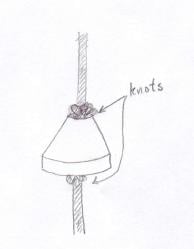
|
Figure 2 - Rope pump piston
The tolerance of the pistons are key, noting that a smaller tolerance will lead to a major reduction in efficiency, while a larger tolerance will effectively lead the piston diameter to be as large (or larger) than the pipe diameter, causing the device to become "stuck."
As the bicycle wheel is turned, the rope and pistons move freely downward, before dipping just under the water surface. The pistons then get pulled into the PVC pipe, and create a suction with the surrounding walls. Upon immediate entrance of the pipe, any water above the piston will begin to be pulled upward. Finally, a spill pipe above the well surface allows water being pulled up to be collected for use. The cycle then repeats itself, as each piston travels along the bicycle wheel, and down into the well once again.[2][3]
Drawbacks of the Standard Rope Pump[edit | edit source]
Although very effective in developing countries, the rope pump still contains many drawbacks, from versatility to user friendliness. Some of these drawbacks include depth limitations, material considerations for separate depths, and the "average" force settled for to move the wheel (i.e. children should be able to pump, meaning that an adult will not be using their maximum amount of force to pump). Table 1 illustrates the suggested diameter tubing for certain water depth levels.
Table 1[4]
| Elevation | Diameter (inner) | Diameter |
|---|---|---|
| 0 - 4 meter | 40 mm | 1.5 inch |
| 4 - 11 meter | 30 mm | 1 inch |
| 11 - 20 meter | 23 mm | 0.75 inch |
| 20 - 60 meter | 18 mm | 0.5 inch |
Due to the lack of tools and supplies, the well depth often cannot be estimated properly. Currently, one of the most accurate ways to measure the depth of a well is as follows:
- Tie a relatively heavy object to the end of a long rope, and lower the rope until it touches the surface of the water
- Tie a knot once the surface of the water is contacted
- Continue lowering the rope until the bottom of the well is touched
- Tie another knot in the rope
- The distance from one knot to the other is the approximate depth of the well
An improper estimation of the well depth can lead to the implementation of an incorrect PVC pipe. If the diameter of the pipe used is too big, too much water may be collected at once. This amount of water may become to heavy to be brought to the surface, rendering the system useless.[5]
The Depth-Adjustable Rope Pump[edit | edit source]
This type of pump uses an adjustable PVC piping system to vary both the depth of the system, and the force needed to bring up water. The pipe is able to be lowered to a desirable depth, and locked in place, so that it remains rigid while in operation. If the pipe is dropped down too low, or the force of pumping becomes to heavy for a child, it may be slowly raised up via the bicycle wheel and a second rope. With this new design, the suggested diameter tubing is shown in Table 2.
Table 2
| Elevation | Diameter (inner) | Diameter |
|---|---|---|
| 0 - 60 meters | 30 mm | 1 inch |
The full design is shown in figures 3, 4, 5 and 6, and is constructed step-by-step in sections below.
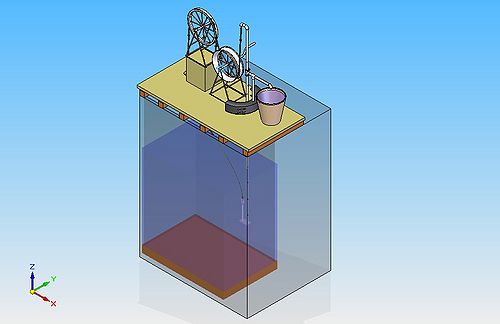 |
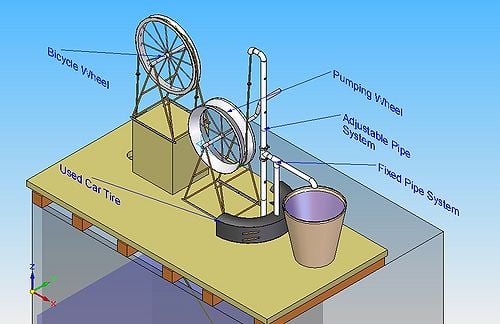 |
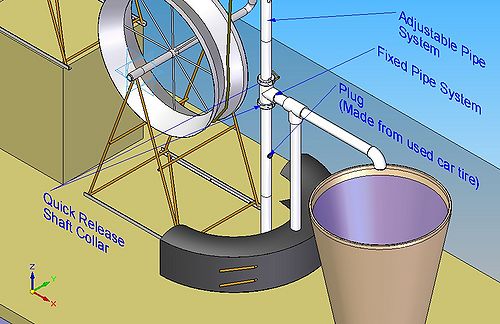 |
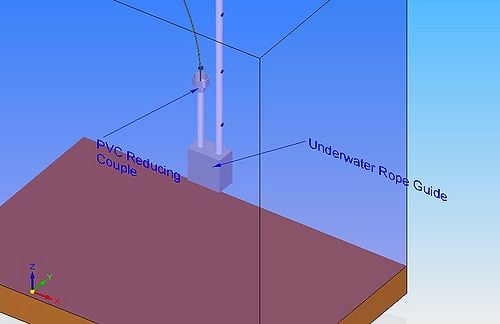 |
Design Components[edit | edit source]
Pumping Wheel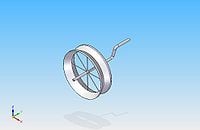 |
The pumping wheel is composed of two inner rings of used car tires, clamped together and held in place by spokes. Once these two rings are clamped together, the 'v' type shape provides enough friction to move the rope, and effectively bring water up the pipe. The exact construction process can be found within the 'How to Make' section of http://www.ropepumps.org. The handle is made from 1" steel pipe, bent into two separate 90-degree angles. |
|---|---|
Well Cover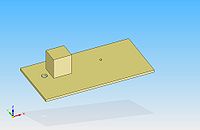
|
The well cover is a platform made from a piece(s) of plywood or even particle board, serving multiple purposes. Firstly, covering the well surface prevents contamination, which can compromise the quality of the water, and cause the pump to become 'stuck' (this can happen if large pieces of debris enter the pipe and become lodged). Secondly, it is a platform for many of the rope pump components to rest or be fixed to. |
Used Car Tire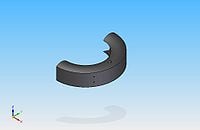
|
This used car tire (found from collecting inner rings to make the pumping wheel) is used as a rigid support, being secured by nails to the well covering, and in turn, holding many piping systems in place through the use of concrete rebar. |
Rope with Pistons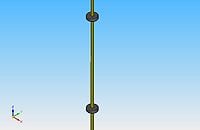
|
The rope runs throughout the entire system, having pistons situated at 1-meter intervals along its length. These pistons can be fashioned out of used car tires, as circles are cut to be precisely the same diameter as the pipe they are to travel through (in this case, 1"). The edges of these circles can then be slightly trimmed, so that they fit through the pipe, but still create a large enough suction to efficiently bring water up. |
1" PVC pipe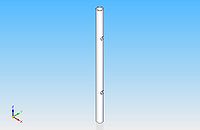
|
Several lengths of PVC tubing is used throughout the system. The model shown here has two holes drilled at 125 mm apart, allowing water brought up from the well to exit. |
1" PVC Elbow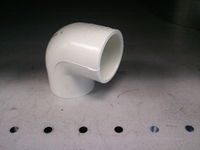
|
The PVC elbow fitting is commonly used throughout the piping system extending down towards the bottom of the well. |
1"/2" PVC T-joint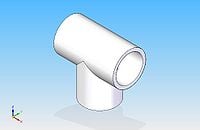
|
The PVC t-joint fitting is commonly used throughout the piping system extending down towards the bottom of the well. |
Bicycle Rim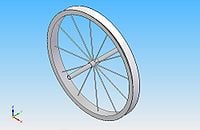
|
In order to keep tension around the pumping wheel, another fixed point is needed. The bicycle rim serves as this point, as it keeps tension in the rope and directs it down into the well. |
Concrete Rebar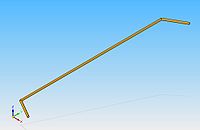
|
This material is used as both a 'lever' for the adjusting collar (see next item), and a restraining piece, holding parts of the piping system to the used car tire. |
Adjusting Collar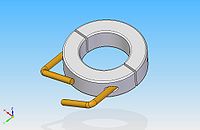
|
The adjusting collar is used to either lower the pipe system (when unlocked) or hold it rigidly in place (when locked). The piece is a product of misumiusa.com, and can be found at http://www.misumi-ec.com/usa/eusaen/ItemDetail/10302155240.html. In order to allow the unit to be quickly release and tightened, without the constant use of a hex-key, small lengths of commonly found concrete rebar are welded to the head of the bolt. The rebar can then be bent to resemble that of a handle. |
Wheel Structure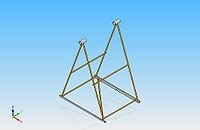
|
Made from pieces of 1-1/4" metal tubing, rebar and two L-shaped brackets all welded together, the wheel structure is responsible for supporting the pumping wheel, and allowing it to freely rotate. |
Underwater Rope Guide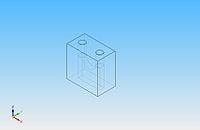
|
This guide is situated underwater, allowing the rope and pistons to smoothly transition from being lowered into the well to rising back up again. The guide can be a block of wood, with a semi-circular (approximately) cut through the bottom, and two 2" holes (again, approximately) cut on each side of the semicircle. |
2"/1" PVC Reducing Couple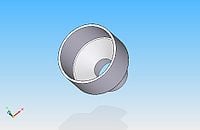
|
The PVC reducing couple fitting is used to accurately guide the rope and pistons into the underwater rope guide, without the pistons getting caught on the side of the pipe. |
Engineering Calculations and Principles[edit | edit source]
For the following calculations, parameters are represented by the following:
- h - pipe extension distance below the water surface (m)
- Lw - length of tubing from surface of the water to water spout (m)
- Lpvc - total length of adjustable PVC pipe in the system (m)
- ρw - density of water (kg/m3)
- ρpvc - density of PVC (kg/m3)[6]
- g - acceleration due to gravity (m/s2)
- Awater - cross-sectional area of water in the pipe (m2)
- Apvc - cross-sectional area of the PVC pipe (m2)
- μ - coefficient of friction between plastic and nylon
- ID - inner diameter of PVC tubing (m)
- OD - outer diameter of PVC tubing (m)[7]
- rcrank - radius of crank handle (m)
- rpumpwheel - radius of the pump wheel (m)
- H - total height of water in the system (m)
- mw - mass of water in the system (kg)
- mc - mass needed to rotate crank (kg)
- Ff - force due to friction (N)
- Fw - force of water in the system (N)
- Fc - force needed to rotate crank (N)
Pumping Calculations[edit | edit source]
The spreadsheet File:Crank forces.xls can be used to determine a variety of required crank forces for different lengths of PVC pipe and below-surface depths. The separate tabs within the excel file represent different depths the pipe extends beneath the surface of the water (d). All the values within the spreadsheet are based on the following calculations.
The system can be simplified in order to accurately make calculations relevant to the user. Figure 7 shows where the load of the pulley system is situated.
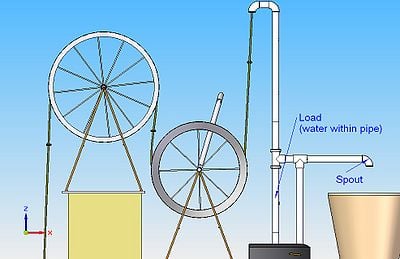 |
Figure 7 - Load in the pulley problem
In order to calculate exactly how 'hard' a user is to rotate the crank to bring a specified amount of water up, the system shown in figure 7 can now be modeled as in figure 8.
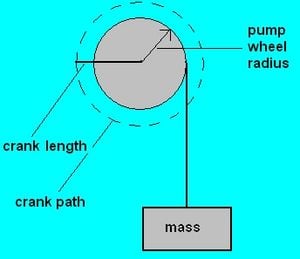 |
Figure 8 - Simplified pulley system
Where the mass represents the total weight of the water being pumped upwards. However, it can also be noticed that in figure 7, the rope passes through two elbow sections, and changes direction before it passes the pump wheel. Because of this, the frictional force of the rope along this length of elbow sections will also have to be considered in the calculation.
Therefore, 'mw' now represents the total mass of water being pumped upward in the pipe. The force of the water, Fw, can then be found.
Not only does the water traveling up the pipe create a force on the pump crank, but the transition piece shown in figure 9 presents an added resistance as well. As the rope travels to the very top of the pipe, it turns a gradual 90-degrees, following the path of the connected elbow. Because the rope is almost instantaneously brought back through another elbow and fed downwards, the rope will tend to slide along the horizontal portion of the pipe. The problem at hand can then be modeled using the scenario in figure 10.
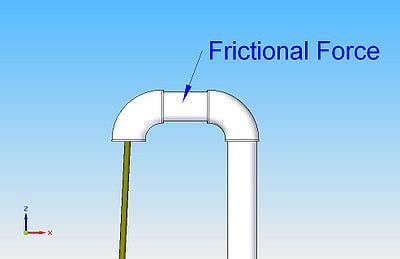 |
Figure 9 - Friction in the pipe
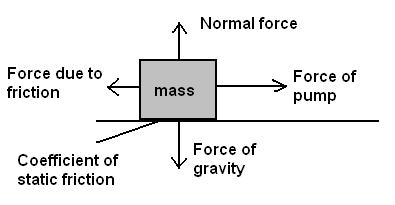 |
Figure 10 - Simplified forces on the rope through the horizontal section
The coefficient of dynamic friction of PVC on steel is quoted as 0.25. However, steel, with a dynamic coefficient of 0.8, is much higher than that of nylon (0.2). Therefore, a lower coefficient of friction of approximately 0.1 is used for nylon on PVC. Therefore, the force due to friction can be calculated by using the coefficient of friction as the ratio of forces.[8][9]
The total force on the pump crank can then be calculated by simply adding the force due to friction with the force of the water rising in the pipe. The force felt by the user rotating the crank can then be computed by referring to figure 8. The forces of each the water and the crank are proportional to their respective lengths.
CHECK EQUATIONS
Lifting Calculations[edit | edit source]
Being a depth-adjustable pump, sometimes the piping system will need to be lifted if the force of pumping is greater than the user can handle. The simple method of draining the PVC pipe before lifting is explained in the Technical Details section. After the pipe is completely drained, the mass being lifted upward is made up of the adjustable section of PVC piping, along with its fittings (the mass of the underwater rope guide can be neglected due to the small nature of its size). The mass of the adjustable PVC pipe in the system can be
Based on the previous calculations, figure 11 shows the length of adjustable PVC tubing within the system, and its corresponding weight when lifting. It is important to keep in mind that part of this tubing may be submerged, which would make the system easier to lift upwards.
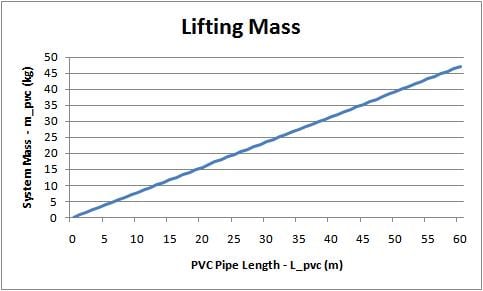
Figure 11 - Lengths of PVC tubing and their corresponding masses
Required Materials and Tools[edit | edit source]
Much of the major required materials are outlined in the design components section and are readily available locally. However, there are other small materials and tools needed in order to fully construct the pump and make it operable. Simple tools such as hammers and hand-drills should be readily available in order to open parts of the well cover to the well surface, as well as to fix certain components permanently to the well cover.
Small-scale materials[edit | edit source]
Some smaller materials needed to construct the pump are outlined.
- PVC cement is needed to connect piping. A guide to PVC gluing can be found at http://www.hammerzone.com/archives/plumbing/technique/pvc/gluing/joining_pipe.htm. As an alternative to glue, the pipes can be connected and the outside can be heated to its melting point, where the two joints will fuse.
- Any range from 10d to 60d box nails - information on sizing can be found at http://www.sizes.com/tools/nails_smooth_box.htm.
- Wooden beams - at least 2in x 4in - used as a support for the well cover. See http://web.archive.org/web/20200416201419/http://www.ropepump.com:80/:80//images/InstallationManual.pdf Specifications of the well covers and structures to fasten the rope pump.
Required Tools[edit | edit source]
- hammer
- hand drill
- panel saw
- stick welder - DOY ideas can be found at http://www.instructables.com/id/Weld/
Required Skills[edit | edit source]
The construction of the adjustable rope pump should be, at the very least, overseen by any person with experience in building and welding. When constructing either the original rope pump or the adjustable rope pump, relatively large-scale construction is being performed over a very hazardous surface. It is recommended that the system is constructed in groups, so that supervision is present at all times of construction.
Proper construction of the original rope pump can be found at http://web.archive.org/web/20200416201419/http://www.ropepump.com:80/:80//images/InstallationManual.pdf.
Construction[edit | edit source]
- The construction of the main support well cover can be found at http://web.archive.org/web/20200416201419/http://www.ropepump.com:80/:80//images/InstallationManual.pdf
Fixing components to the well cover[edit | edit source]
Figure 12 shows the cut-outs on the well cover and tire. Note that the holes in the well cover do not need to be exact, just ensure that there is enough space for the pistons along the rope to move through.
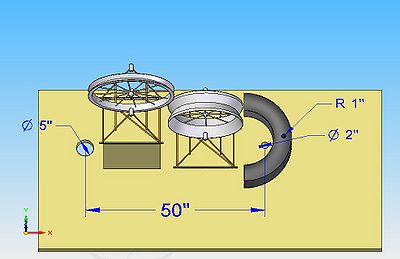 |
Figure 12 - Dimensions on well cover drills
Figure 13 shows the orientation of each structure. Note that the bicycle wheel frame and the pump wheel frame should be positioned so that the edge of the bicycle wheel is approximately vertically in-line with the edge of the pumping wheel.
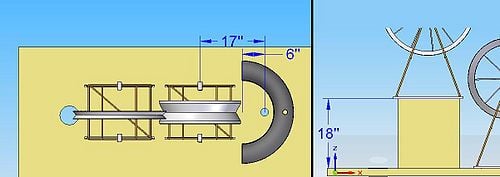 |
Figure 13 - Fixed component distances
The three components can then be fixed with the required box nails outlined in the Required Materials section.
Fixing the wheels[edit | edit source]
Figure 14 shows the welding point at which the pumping wheel is welded to its 1" steel pipe. The long steel pipe can then be bent into two separate 90-degree bends, creating a handle. The bend is shown in figure 15. It should also be noted that the vertical length of the handle will determine how easy it is to pump. In the calculations done in File:Crank forces.xls, the handle extends approximately 160% of the wheel diameter.
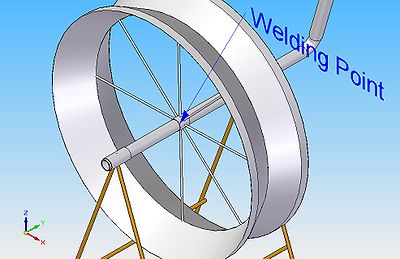 |
Figure 14 - Weld point
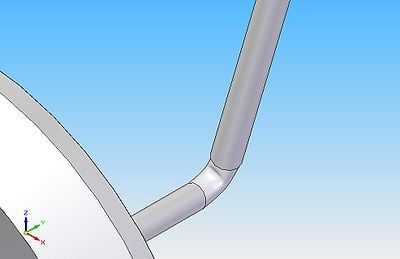 |
Figure 15 - This type of bend can be done with a hammer
Fixed Pipe System[edit | edit source]
Note: the fitting of PVC can be found in the link provided in the Required Materials section.
Figure 16 shows the setup of the fixed pipe system - the section of piping that will remain stationary at all times. This system is made up of 2" PVC piping and fittings. Within figure 16, the t-joint T1 should be axial aligned with the hole in the well cover within the tire, while T2 should be axial aligned with the hole in the tire. The other part of figure 16 shows how rebar is used to secure the piping to the tire. These holes for the rebar can be made using a hand drill. The ends of the rebar are bent to the circumference of the tire, to ensure there is no movement.
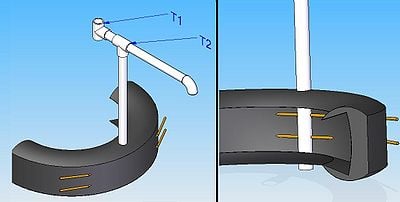 |
Figure 16 - The fixed pipe system
The Rope[edit | edit source]
The approximate length of the rope can be found by determining the entire depth of the well (determined in the Background section. Multiply the entire depth of the well by 2. Next, with the rope itself, run it through the above-ground system (ie. the pumping wheel and the bicycle wheel) and measure the length of this system. Add approximately 10 feet to the total length, since the rope will run at an angle to the vertical when ascending into the well. Once again, extra length to the rope to compensate for knots, which will be used to hold the pistons.
Once pistons are cut from the other half of the used car tire, they can be stranded onto the rope one-by-one. At each 1-meter section, a knot can be tied below and above the piston, in order to hold it rigidly in position.
Adjustable Pipe System[edit | edit source]
Firstly, the underwater rope guide is to be set up. Figure 17 shows the underwater rope guide, with a 6-inch-long, 1-inch-diameter PVC pipe with a 2" reducing couple on the end. If cut properly, the PVC pipe can be hammered into the rope guide, and held simply by a press fit (ie. no glue needed). On the other side of the rope guide is a 1-foot, 1-inch diameter PVC pipe, which will eventually be extended to match the specifications of the well depth.
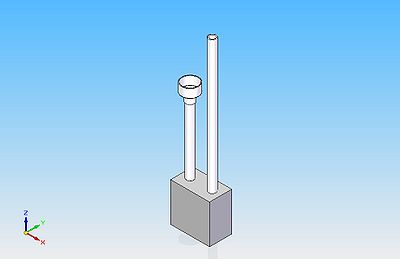 |
Figure 17 - The underwater rope guide
Once the rope guide is constructed, the rope can be fed through both ends. Shift the well cover so the drilled holes are above solid ground, and no longer above the well. Place the underwater rope guide beneath the well cover, and feed the rope through either hole. Pull the rope tight, and tie one end to the frame of the bicycle wheel, and the other end to the vertical PVC pipe of the fixed pipe system. The well cover can then be moved back over the well, and secured in place.
The system should then resemble figure 18.
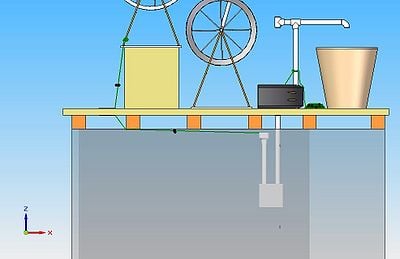 |
Figure 18 - System with rope attached
Additional PVC piping can then be added until the top of the guide approximately matches the surface of the water. As lengths of PVC tubing are pieced together, it should be noted that the rope must be fed through each additional piece first. Once the rope guide meets the surface of the water, and the lengths of tubing meet the spout, any additional PVC lengths will need holes drilled 125 mm apart, so the rising water can exit.
Attach the collar to the PVC tubing, just above the 2-inch t-joint shown in figure 19, and tighten it.
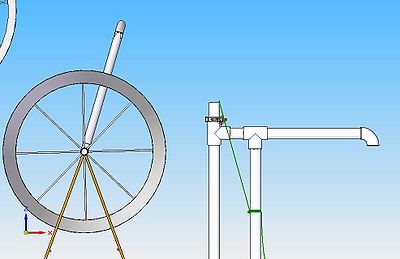 |
Figure 19 - Collar attachment
Next, the remaining lengths of PVC tubing can be connected. This can be done separately on the ground, away from the system. This separate length of the PVC tubing should be the length from the surface of the water, to the bottom of the well, which was measured earlier. The difference in this set of PVC tubing is however, holes must be drilled into the side of the pipe at just under 5 inch (125 mm) intervals. Once this has been completed the directional piece can be added on top. This is shown in figure 20.
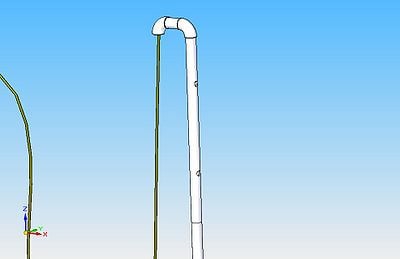 |
Figure 20 - Drilled pipe section
Next, run the rope through the extended section, and attach the extension to the rest of the adjustable system. Place the other collar onto the other side of the t-joint, and tighten (this prevents the system from moving upwards during pumping). The system is finished and should resemble figure 21. Congratulations on your new rope pump! Please see the Technical Details section to learn how to use it.
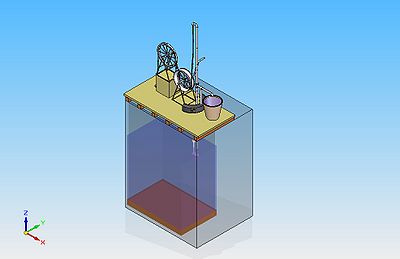 |
Figure 21 - The finished product
Cost Estimation[edit | edit source]
The prices of various components are outlined in table 3. The references from which quotes were taken are outlined in File:Rope pump pricing.xls
Table 3
| Unit | Price |
|---|---|
| 2" PVC Elbow | $ 1.17 |
| 1" PVC Elbow | $ 0.38 |
| 2" PVC T-joint | $ 1.78 |
| 1" PVC T-joint | $ 0.57 |
| 1-2" PVC Pipe Reduction | $ 2.72 |
| 1-1/4" Shaft Collar | $ 7.50 |
| PVC Cement 16 0z. (optional) | $ 16.64 |
| 10d Box Nails (1Lb.) | $ 4.60 |
PVC was also quoted to be $1.56/foot ($5.12/meter) for 1-inch and $3.49/foot ($11.45/meter).
Table 4 then calculates different prices based on the total length of the adjustable system. The in depth calculations can once again be found in File:Rope pump pricing.xls
Table 4
| Length of Adjustable System (m) | Price (with PVC cement) | Price (without PVC cement) |
|---|---|---|
| 5 | $ 81.49 | $ 64.85 |
| 10 | $ 107.08 | $ 90.44 |
| 15 | $ 132.67 | $ 116.03 |
| 20 | $ 158.26 | $ 141.62 |
| 25 | $ 183.85 | $ 167.21 |
| 30 | $ 209.44 | $ 192.80 |
| 35 | $ 235.03 | $ 218.39 |
| 40 | $ 260.62 | $ 243.98 |
| 45 | $ 286.22 | $ 269.58 |
| 50 | $ 311.81 | $ 295.17 |
| 55 | $ 337.40 | $ 320.76 |
| 60 | $ 362.99 | $ 346.35 |
Any items not included in the cost estimation are assumed to be found locally. All prices are based on USD and are priced in North America. Pricing may differ from location to location.
Technical Details[edit | edit source]
This section deals with the different mechanisms by which the adjustable rope pump operates.
Lowering and Lifting[edit | edit source]
The shaft collars are the two components responsible for both holding the adjustable pipe system in place, and allowing it to move. If the force needed to turn the crank becomes very low, and not much water is being pumped, the system can be lowered in order to pump more water.
First, remove the bottom shaft collar. Next, slowly loosen the top shaft collar until the pipe system begins to move. Once a hole lines up with the spout, the collar can be tightened once again. It is very important that any holes now below the spout are plugged. These plugs can be made from the other half of the used car tire, cutting a circle just larger than the hole diameter. The plug can then be 'wedged' into place, or heated until it fuses with the pipe. It is important that the plug not be pushed past the inner diameter of the pipe, as it will obstruct with pistons which are carrying water up the pipe length.
Refer to figures 22 and 23 to see both how the system lowers, and how the holes are plugged.
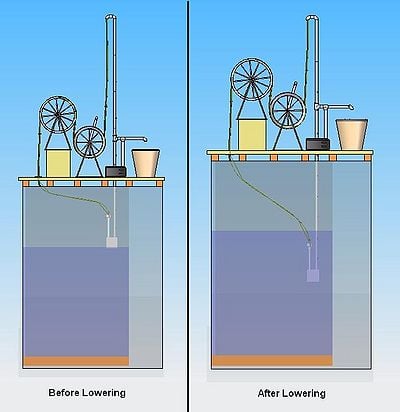 |
Figure 22 - Lowering the rope pump
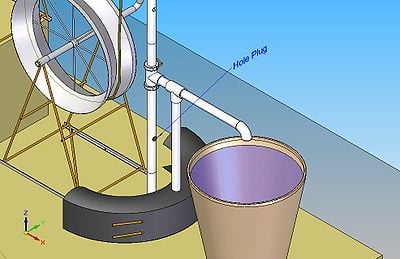 |
Figure 23 - Plugging the hole
Lifting can be accomplished in almost the same process as lowering. If one finds that the force needed to turn the crank is too much, water must be pumped in the opposite direction. This takes no work, as gravity will do all the work. Simply turn the crank the other way (it may just need a quick push), and water will begin to lower itself down the pipe. When the water is drained, simply disconnect both shaft collars, and raise the pipe until a hole with a plug comes into view. Remove this plug and line the hole up with the spout. Connect and tighten the collars and begin pumping!
Locking the Wheel[edit | edit source]
If the wheel remains unlocked, there is a very good chance that gravity will push the water in the pipe downwards, flinging the crank handle in a violent manner. In order to prevent this, a locking mechanism can be employed. Take a box nail and wrap a short-length rope around it many times. Drive the nail into the well cover, just below the handle. Bring the handle down to the bottom of its rotation, and wrap the remaining length of the rope around it, tying a knot. This knot can be slipped on or off whenever the wheel needs to be locked.
Additional Considerations[edit | edit source]
It should be known that this model has not undergone a prototyping stage. All concepts discussed on this page may seem correct - however, it is encouraged that other motivated people contribute to this technology in any way possible, in an effort to make it safer, more functional and more sustainable.
References[edit | edit source]
- ↑ "History," Centre des Energies Renouvelables, Madagascar, http://web.archive.org/web/20200416201419/http://www.ropepump.com:80/:80//his/his.htm, April 2, 2010
- ↑ "The Technology," Centre des Energies Renouvelables, Madagascar, http://web.archive.org/web/20200416201419/http://www.ropepump.com:80/:80/, April 2, 2010
- ↑ "Rope Pumps," B.B Design, http://www.ropepumps.org, April 2, 2010
- ↑ "How to Make," Rope Pumps, B.B Design, http://www.ropepumps.org/, April 2, 2010
- ↑ "Installation Manual for the Rope Pump," Centre des Energies Renouvelables, Madagascar, http://web.archive.org/web/20200416201419/http://www.ropepump.com:80/:80//images/InstallationManual.pdf, April 2, 2010
- ↑ "Specific gravity (density)," PVC.org, http://web.archive.org/web/20100507101141/http://www.pvc.org:80/What-is-PVC/PVC-s-physical-properties/Specific-gravity-density, April 10, 2010
- ↑ "PVC and CPVC Pipes," The Engineering Toolbox, http://www.engineeringtoolbox.com/pvc-cpvc-pipes-dimensions-d_795.html, April 10, 2010
- ↑ "Plastics Comparison Table," http://www.machinist-materials.com/comparison_table_for_plastics.htm, April 10, 2010
- ↑ "Coefficient for Static Friction of Steel," Technical Resources for Manufacturing Professionals, http://www.carbidedepot.com/formulas-frictioncoefficient.htm, April 10, 2010








